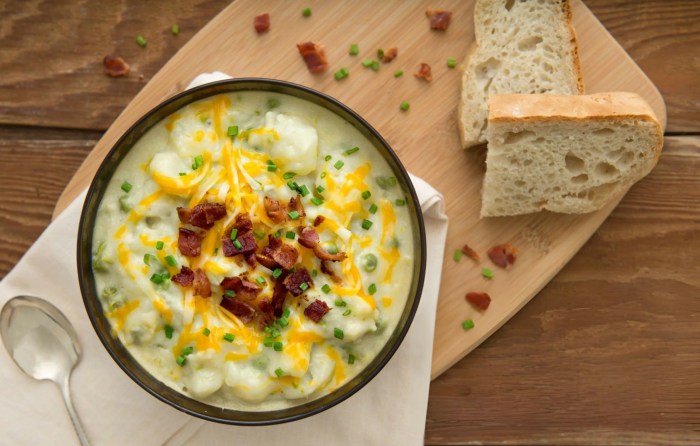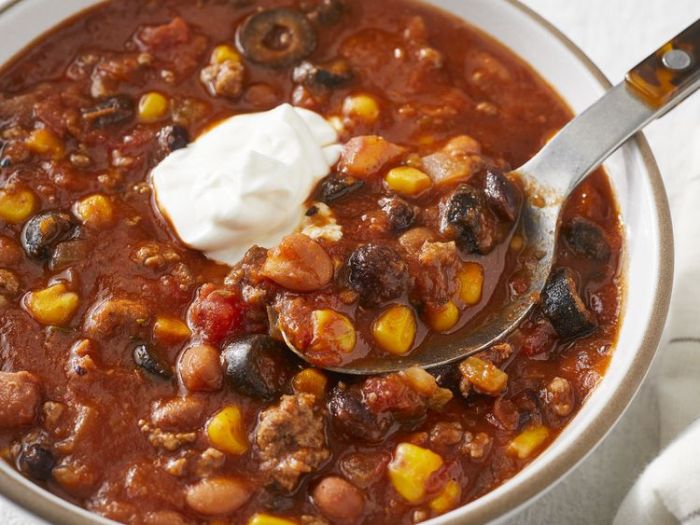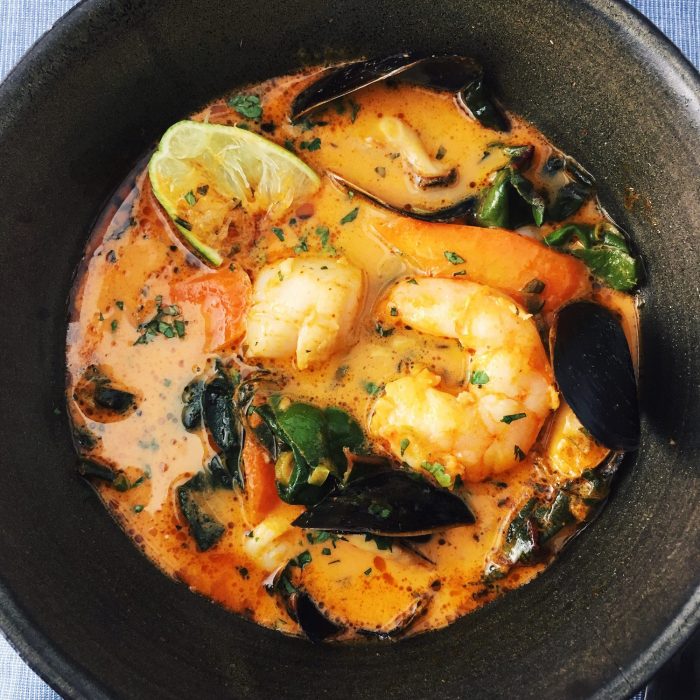Potato Soup: A Culinary Journey
Potato.soup.recipe – Potato soup, a comforting classic enjoyed across the globe, boasts a rich history and diverse culinary interpretations. From hearty, chunky versions to velvety smooth creamy concoctions, its versatility makes it a staple in countless cuisines. This exploration delves into the history, variations, and preparation of this beloved dish, offering a comprehensive guide to crafting the perfect bowl of potato soup.
A History and Cultural Significance of Potato Soup
While pinpointing the exact origin of potato soup is challenging, its popularity aligns with the widespread cultivation of potatoes. In many European cultures, potatoes became a dietary mainstay, leading to the development of various soup recipes. In Ireland, for instance, potato soup often reflects a simpler, more rustic approach, utilizing readily available ingredients. Conversely, French and American versions might incorporate richer elements like cream or cheese, showcasing regional culinary influences.
The cultural significance varies—a simple, nourishing meal in some cultures, a celebratory dish in others.
Types of Potato Soup
Potato soup’s versatility shines in its diverse forms. Creamy potato soup, characterized by its smooth, velvety texture, often features heavy cream or milk. Chunky potato soup maintains the potatoes’ integrity, offering a more substantial bite. Loaded potato soup takes it a step further, incorporating toppings like bacon, cheese, chives, and sour cream for a decadent experience. Each variation caters to different palates and preferences.
Nutritional Benefits of Potato Soup Ingredients, Potato.soup.recipe
Potatoes themselves are a good source of potassium and vitamin C. The addition of other vegetables like carrots, celery, or onions further boosts the nutritional profile, contributing vitamins, minerals, and fiber. Dairy products like milk or cream (in creamy versions) provide calcium, while additions such as bacon or cheese contribute protein and fat. The overall nutritional value depends heavily on the specific recipe and ingredients used.
Basic Potato Soup Recipe

Source: sonerijobs.com
This recipe provides a foundational understanding of potato soup preparation. It focuses on simplicity and ease, allowing for customization and experimentation.
Step-by-Step Potato Soup Preparation
- Dice 2 lbs potatoes (Yukon Gold recommended).
- Sauté 1 chopped onion and 2 cloves minced garlic in 2 tbsp butter until softened.
- Add diced potatoes, 6 cups vegetable broth, 1 tsp salt, and ½ tsp black pepper to the pot.
- Bring to a boil, then reduce heat and simmer for 20-25 minutes, or until potatoes are tender.
- Use an immersion blender to achieve desired consistency (creamy or chunky).
- Stir in ½ cup milk or cream (optional) for extra creaminess.
- Garnish with fresh chives or parsley before serving.
Cooking Times for Different Potato Varieties
| Potato Variety | Boiling Time (minutes) | Simmering Time (minutes) | Notes |
|---|---|---|---|
| Yukon Gold | 15-20 | 20-25 | Creamy texture, good for mashing |
| Russet | 20-25 | 25-30 | Fluffy texture, holds shape well |
| Red | 18-22 | 22-27 | Waxy texture, good for soups |
| Fingerling | 12-15 | 15-20 | Smaller size, cooks quickly |
Variations and Enhancements: Potato.soup.recipe
The beauty of potato soup lies in its adaptability. Countless flavor profiles can be achieved through simple ingredient additions.
Flavor Profile Enhancements
Experiment with herbs like thyme, rosemary, or sage for earthy notes. Spices such as smoked paprika, cumin, or curry powder add depth and complexity. Different cheeses, from cheddar to Gruyere, contribute unique creamy textures and tastes. Bacon or ham adds smoky saltiness, while roasted vegetables introduce sweetness and complexity.
Specific Variations
- Creamy Potato Soup with Bacon: Incorporate crispy bacon bits and a generous amount of heavy cream.
- Cheddar Potato Soup: Stir in shredded cheddar cheese during the last few minutes of cooking.
- Potato and Leek Soup: Replace onions with leeks for a subtle sweetness and delicate flavor.
Cooking Methods
Potato soup can be prepared on the stovetop, in a slow cooker for a hands-off approach, or in an Instant Pot for faster cooking times. Each method yields slightly different textures and flavors.
Visually Appealing Presentation
A simple garnish can elevate the soup’s visual appeal. Fresh herbs, a swirl of cream, or crispy bacon bits add texture and color. Serving in rustic bowls or elegant ramekins also enhances the presentation.
Serving Suggestions and Pairings
Potato soup is best enjoyed with complementary accompaniments that enhance its flavors and textures.
Accompaniments and Side Dishes
Crusty bread is a classic pairing, perfect for soaking up the creamy broth. A simple side salad with a light vinaigrette provides a refreshing counterpoint to the richness of the soup. A grilled cheese sandwich offers a comforting and cheesy complement.
Beverage Pairings
- A crisp white wine, such as Sauvignon Blanc.
- A light-bodied beer, like a Pilsner.
- Hot tea or coffee.
Serving Temperatures and Occasions
- Serve hot for a comforting meal on a chilly evening.
- Slightly cooled, it’s perfect for a picnic or potluck.
- Ideal for casual dinners, family gatherings, or even a cozy night in.
Troubleshooting and FAQs
Addressing common challenges ensures a consistently delicious outcome.
Common Problems and Solutions

Source: dishpulse.com
- Lumpy soup: Use an immersion blender to achieve a smoother consistency. Alternatively, carefully purée a portion of the soup in a regular blender before returning it to the pot.
- Bland flavor: Add more salt, pepper, or herbs to taste. A splash of lemon juice or Worcestershire sauce can also enhance the flavor profile.
Storage and Reheating
Store leftover soup in an airtight container in the refrigerator for up to 3 days. Reheat gently on the stovetop or in the microwave, stirring occasionally to prevent scorching.
Dietary Adaptations

Source: scripturalthinking.com
For a vegetarian version, simply omit any meat products. For a vegan version, use vegetable broth and replace dairy with plant-based alternatives like coconut milk or cashew cream.
Visual Representation of Recipe Stages
The visual journey of potato soup preparation is as captivating as its taste. Initially, the diced potatoes appear pale and firm. As they simmer, they soften and become translucent, absorbing the broth’s color. The onion and garlic sautéed initially release their aromas and transition to a golden-brown hue. The final product, depending on the recipe, ranges from a creamy off-white to a richer, more golden color, showcasing the depth of flavor achieved.
The texture shifts from chunky to creamy, depending on the blending process, while the aroma evolves from a subtle vegetable scent to a rich, savory fragrance.
Commonly Asked Questions
Can I use leftover cooked potatoes?
Absolutely! Pre-cooked potatoes will reduce cooking time significantly. Just be sure to adjust the cooking time accordingly to prevent overcooking.
How can I thicken my potato soup?
If your soup is too thin, you can thicken it by simmering it uncovered for a longer time to reduce the liquid. Alternatively, a cornstarch slurry (cornstarch mixed with cold water) can be added to achieve a thicker consistency.
What are some vegetarian/vegan alternatives for bacon or cream?
For a vegetarian version, consider using pancetta or crispy fried tofu. For vegan options, vegetable broth, coconut milk, or cashew cream provide richness and creaminess.
Crafting the perfect potato soup recipe often involves considering complementary flavors. A creamy potato soup, for instance, might benefit from the addition of herbs reminiscent of other classic soups, such as those found in a hearty pea soup Andersen’s recipe. Understanding the nuances of different legume-based soups can enhance your potato soup’s overall depth and complexity, ultimately leading to a more satisfying culinary experience.
How long can I store leftover potato soup?
Store leftover potato soup in an airtight container in the refrigerator for up to 3-4 days. Reheat gently on the stovetop or in the microwave.


